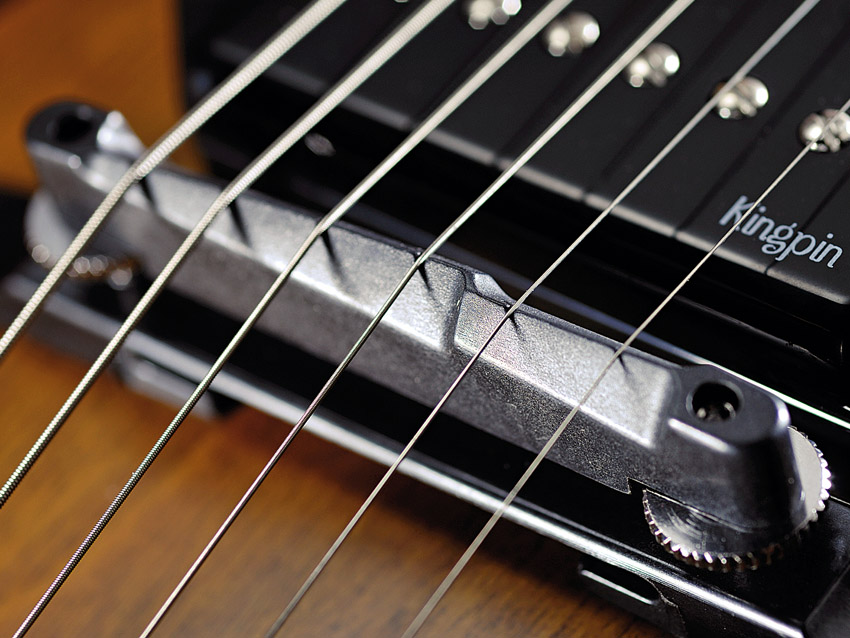MusicRadar Verdict
Despite some build concerns, it's the broad range of sounds that win through here.
Pros
- +
Old-style vibe. Versatile sounds. Build.
Cons
- -
Set-up. Small frets. Neck angle
MusicRadar's got your back

Godin 5th Avenue CW Kingpin

Godin 5th Avenue CW Kingpin

Godin 5th Avenue CW Kingpin
Launched back in 2008, few pundits would have given an acoustic archtop much of a lifespan. But the very retro 5th Avenue has become quite a success for a brand more associated with modernist, often hi-tech designs.
This fully powered, cutaway 5th Avenue CW Kingpin - like each of the 5th Avenue trio - comes with a neat, light Tric case that accounts for £89 of your outlay.
"Sound-wise it's hard to fault - dialling up a wide selection of jazz, blues, classic pop, rockabilly and more contemporary lo-fi crunch with aplomb."
Made from Neopolen P expanded Polyproylene, it offers the protection of a hard case and is only slightly heavier than a deluxe gigbag. But its high-tech design is certainly at odds with the 5th Avenue lurking inside.
Essentially a 406mm (16- inch) wide archtop with a 76mm (three-inch) rim depth, it's very slightly smaller than the Gibson ES-125 on which it's clearly styled. The rounded cutaway is less Gibson and more acoustic-like, while the body is made from laminated wild cherry, tidily cream-bound back and front.
The silver leaf maple neck glues into the body at the 14th fret, the remaining neck portion sits (just) over the top of the body. Through the clean f-holes you can see old-style kerfed linings - it's a very clean job.
The neck sits quite high over the body, however, even for an archtop of this style, and this means that the strings sit some 25-28mm off the front. The dual dog-ear P-90s are mounted on substantial spacers and the two-piece archtop-style bridge (made by Graph Tech from black Tusq) is adjusted some 6mm off its foot.
Want all the hottest music and gear news, reviews, deals, features and more, direct to your inbox? Sign up here.
This raised feel does take a little adjustment playing-wise - other 5th Avenues we've checked have a flatter neck angle, and therefore lower bridge height, which indicates some production variances. It's not helped by small gauge 'acoustic' fret wire that's a little sharp edged, a sloppy set-up and an absence of dot markers past the 12th fret.
However, the full but well-shaped neck is nice enough with a subtle flame to the brown-stained maple and a slight in-turn to the fingerboard edge. But overall - especially in this satin cognac burst, a 'custom polished finish' that Godin states "creates a gorgeous satin sheen reminiscent of the French polish of the 19th century" - it certainly has old-school charm by the bucket-load.
The Godin pickups, aside from the small logo, look pretty vintage-accurate, as do the silver-topped control knobs for the master volume and tone. The pickup selector is shoulder-mounted, but the standard output jack is mounted through the side.
If that outer nut works lose (it will) the whole socket can drop inside the guitar and you'll have 'fun' - especially backstage before you're about to go on - getting it out!
Sounds
Acoustically, the laminate archtop sound can be an acquired taste and the 5th Avenue doesn't broaden that appeal with its slightly 'tinny' mid-range honk that lacks the depth of our comparison guitar, a fifties Hofner Congress, which still has that mid-range, but with more looseness and a far wider dynamic range. The Godin sounds tighter.
Plugged in it proves to be a very characterful and versatile guitar. Both the volume and tone, when reduced, round out the sound for a smoother-nosed attack - the P-90s aren't that powerful so cleaner jazz and blues tones are easily achieved; it works with crunchier gain too but, of course, volume is limited by its hollow body and easily coaxed feedback.
A little more care in the set-up - and some bigger frets - would elevate it considerably.
Easily the coolest-looking design in the Godin cannon, this fully loaded 5th Avenue is quite a guitar. Okay, that over-high neck position does take some getting used too, and a better out of the box set-up (and heavier frets) would enhance the experience, but sound-wise it's hard to fault - dialling up a wide selection of jazz, blues, classic pop, rockabilly and more contemporary lo-fi crunch with ease.
It's also nice to have a thin old-style finish, not an over-done high gloss - it certainly suits the vintage illusion: here's a guitar that should definitely be on anyone's must-try list.
Dave Burrluck is one of the world’s most experienced guitar journalists, who started writing back in the '80s for International Musician and Recording World, co-founded The Guitar Magazine and has been the Gear Reviews Editor of Guitarist magazine for the past two decades. Along the way, Dave has been the sole author of The PRS Guitar Book and The Player's Guide to Guitar Maintenance as well as contributing to numerous other books on the electric guitar. Dave is an active gigging and recording musician and still finds time to make, repair and mod guitars, not least for Guitarist’s The Mod Squad.
